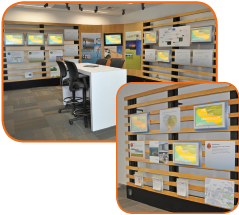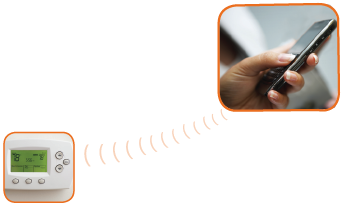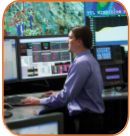Page Content
Powering the new grid, advancing smart technology
Emerging technologies combined with innovative thinking are transforming the power grid. While consumers get ready to benefit from smart devices that empower wise energy choices and control costs, power grid operators are using advanced smart grid tools to make keeping the lights on easier and more efficient while producing zero emissions.

Emerging software technologies upgrade the ability to detect and react to grid issues faster and with finer detail. Maintaining a reliable flow of electricity requires matching supply and demand down to a narrow bandwidth. ISO control centers take a pulse of the power grid every four seconds to balance system needs. Most electrons are consumed the instant they are created. Not enough or too many megawatts on the grid can compromise electricity reliability.
ISO operators manage this dynamic and delicate balancing act invisibly and on behalf of consumers who expect instant light at the flip of a switch. For about 100 years, not much changed in the way electricity was generated and delivered. Recently, times are changing.
What is a smart grid?
Current system modernization referred to as “smart grid technologies” involves applying intelligent tools to create two-way communication between consumer devices and the power grid. Thermostats, for instance, already respond to signals the power grid sends in  a way that makes it possible for individual electricity demand to be curtailed. Personal electricity usage data is now at the fingertips of consumers using smart phones and the Internet and will soon be available in real-time.
a way that makes it possible for individual electricity demand to be curtailed. Personal electricity usage data is now at the fingertips of consumers using smart phones and the Internet and will soon be available in real-time.
Residential and business customers stand to earn substantial savings on their utility bills as a result of interacting with the power grid. “Set-and-forget” automation will enable consumer devices to “talk” to the grid without bothering the customer. The device will know the price at which its owner is willing to cut back on usage in order to earn revenue.
The perfect green partner

Recent environmental and energy policies require the ISO to prepare the grid for absorbing the largest portfolio of renewable power in the country—a 33% green power mix by 2020. Demand response or consumer-enabled curtailments can be paired with the variable output of renewable power when the wind doesn’t blow or the sun doesn’t shine. This “people power” kicks in seamlessly to smooth fluctuations in renewable output.
Negawatts

Often, the cheapest and cleanest megawatt is the one that isn’t used. Think of these reductions as “negawatts”. This is where the smart grid becomes a genius. The ISO regards demand response as a flexible resource to nurture. Essentially, taking demand off the grid is equal to injecting supply onto the grid. In fact, the ISO is paving the way for demand response to compete in the wholesale energy market, dispatching it just as it would a typical power plant.
Smarter forecasting
Advancing tools to manage a reliable power grid means leveraging technology that helps forecast weather impact on consumer demand and renewable power output. With dynamic conditions increasing for

electricity supply as well as demand, grid operators are using smarter equipment and systems to stay one step ahead of Mother Nature. Tapping smarter forecasting applications is also key to managing fluctuations in consumer demand. Hotter or colder than expected temperatures throw off consumer load forecasts, causing air conditioning or heating to trigger dramatic swings in demand. More dynamic changes in demand are also coming from the rapid growth in rooftop solar units self-powering homes and businesses. The power grid quickly steps in with backup power when it is cloudy. Anticipating consumer needs will become even more important as electric vehicle ownership increases and electricity is used to “fill up” zero emission cars.